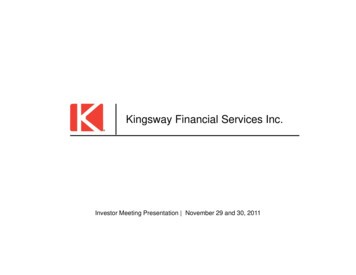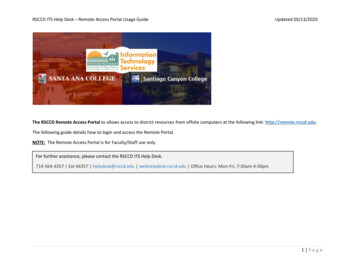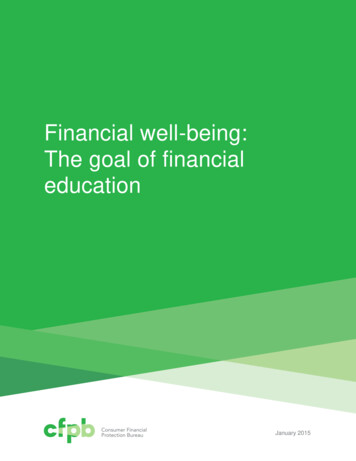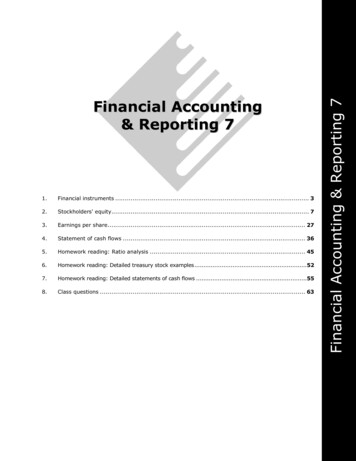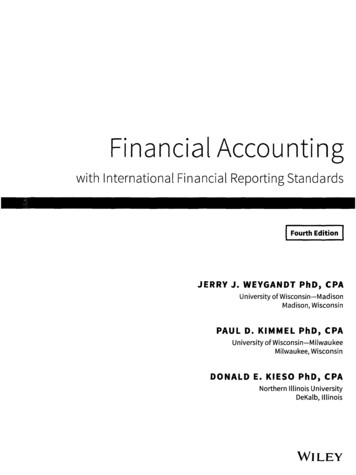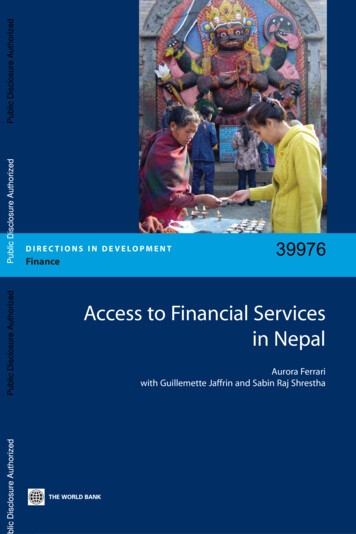
Transcription
Public Disclosure AuthorizedPublic Disclosure AuthorizedPublic Disclosure Authorizedblic Disclosure AuthorizedDIRECTIONS IN DEVELOPMENTFinance39976Access to Financial Servicesin NepalAurora Ferrariwith Guillemette Jaffrin and Sabin Raj Shrestha
Accessto Financial Servicesin Nepal
Accessto Financial ServicesIn NepalAurora FerrariwithGuillemette JaffrinandSabin Raj ShresthaTHE WORLD BANKWashington, D.C.
2007 The International Bank for Reconstruction and Development/The World Bank1818 H Street NWWashington DC 20433Telephone: 202-473-1000Internet: www.worldbank.orgE-mail: feedback@worldbank.orgAll rights reserved1 2 3 4 5 10 09 08 07This volume is a product of the staff of the International Bank for Reconstruction andDevelopment/The World Bank. The findings, interpretations, and conclusions expressedin this volume do not necessarily reflect the views of the Executive Directors of The WorldBank or the governments they represent.The World Bank does not guarantee the accuracy of the data included in this work. Theboundaries, colors, denominations, and other information shown on any map in this workdo not imply any judgement on the part of The World Bank concerning the legal status ofany territory or the endorsement or acceptance of such boundaries.Rights and PermissionsThe material in this publication is copyrighted. Copying and/or transmitting portions orall of this work without permission may be a violation of applicable law. The InternationalBank for Reconstruction and Development / The World Bank encourages dissemination ofits work and will normally grant permission to reproduce portions of the work promptly.For permission to photocopy or reprint any part of this work, please send a requestwith complete information to the Copyright Clearance Center Inc., 222 RosewoodDrive, Danvers, MA 01923, USA; telephone: 978-750-8400; fax: 978-750-4470; Internet:www.copyright.com.All other queries on rights and licenses, including subsidiary rights, should be addressedto the Office of the Publisher, The World Bank, 1818 H Street NW, Washington, DC 20433,USA; fax: 202-522-2422; e-mail: pubrights@worldbank.org.ISBN-10: 0-8213-6989-XISBN-13: 978-0-8213-6989-0eISBN: 0-8213-6990-3DOI: 10.1596/978-0-8213-6989-0Cover photo: Sabin Raj ShresthaCataloging-in-publication data has been requested.
iixExecutive SummaryxiChapter The Supply of Financial ServicesRecent Developments in the Financial SectorGovernment Efforts to Increase Access to Financial ServicesDespite Government Efforts, Access to Financial Services Is DecliningRemittances Are a Missed Opportunity for the Financial Sector115711Chapter The Demand for Financial ServicesMost Deposit Accounts Are Held by Banks, Followed Closelyby Financial NGOs and CooperativesFor Loans, Financial NGOs and Cooperatives Are the Largest ProvidersFor Payment and Remittance Services, the Informal Sector Dominates15162023Chapter Constraints to Increased Access for Small Businessesand Low-income HouseholdsGovernment Policies Have Not Tackled the Root Causes of Low AccessWhy Don’t Banks Scale Up Lending to Small Businesses?Why Haven’t Microfinance Institutions Provided More FinancialServices to Low-income Households?Why Do Informal Channels Dominate the Remittance Market?2727283641Chapter Making the Financial Sector Work for Small Businessesand Low-income HouseholdsKey Principles for Successful Government InterventionHelping Banks Expand Lending to Small BusinessesHelping Microfinance Institutions Serve More Low-income HouseholdsMaking Remittances More Effective4343444853Appendix A Legal Framework of the Regulated Microfinance SectorAppendix B Performance of Regulated Microfinance InstitutionsAppendix C The Access to Financial Services SurveyAppendix D Households Receiving Foreign RemittancesBibliography5557707577Index79
ForewordA publication on access to financial services in Nepal could not be more timely.The recent political developments and social movements across the country arethe result of deep dissatisfaction with how the market economy has worked—ornot worked—in Nepal.Nepal has not fully reaped the benefits of a market economy. Although therehave been considerable improvements in the 10 years since liberalization began,the average per capita income is just 270, and nearly a third of the populationlives below the poverty line—making Nepal the poorest country in South Asia andone of the poorest in the world.The introduction of market principles has also not yielded the desired outcomesin the financial sector. Over the past decade the financial sector has increased inboth size and number of institutions, and has become more stable. But access toand use of financial services remain limited. Only 26 percent of households havea bank account, and 45 percent of these households prefer to save at home—while53 percent prefer to borrow from the informal sector.Although stable financial systems are essential for economic growth, stabilitydoes not necessarily result in an inclusive financial sector. To help reduce poverty,the financial sector needs to be inclusive as well as stable. For example, access tosavings helps poor people cope better with shocks such as health care emergencies. Through access to credit, they can invest in income-generating activities or,in the future, by obtaining education or migrating. Financial services also play animportant role in supporting the growth of small businesses—crucial for creatingjobs for low-skill workers.Surprisingly, access to financial services has not been researched much untilrecently. In fact, there is limited understanding of which factors are important inexpanding access. But despite a lack of theoretical knowledge, several approacheshave worked in practice. These approaches are based on two pillars: supportinginstitutions with potential to expand access and developing an enabling environment (for example, by promoting institutions that increase transparency betweenborrowers and lenders). This report analyzes Nepal’s financial sector and explainshow these approaches could be implemented—benefiting all of Nepal’s people,especially the poor.Praful PatelMichael KleinVice PresidentSouth Asia RegionVice PresidentFinancial and PrivateSector Developmentvii
AcknowledgmentsThis report was prepared by a World Bank team led by Aurora Ferrari under theguidance of Simon Bell and Kenichi Ohachi. Guillemette Jaffrin and Sabin Shresthawere major contributors to the report. The report team also included Angelica Salvi,Juan Muñoz, Elena Glinskaya, Dilip Parajuli, Henry Bagazonzya, Gabi Afram,Sailesh Tiwari, and Richard Rosenberg (Consultative Group to Assist the Poor). Theteam benefited from in-depth discussions with Krishna Gyawali (Nepal's Ministryof Finance), who spent six months at the World Bank as a Humphrey Fellow.The report was funded by the U.K. Department for International Development.Lalima Maskey and Margaret Murray provided administrative support. The reportwas edited by Paul Holtz and designed by Gerry Quinn.The report draws heavily on Nepal’s 2006 Access to Financial Services Survey,undertaken jointly by the World Bank and Total Management Services in associationwith Solutions Consultant. It also draws on several background papers and materials: “Market for Small Business Lending in Nepal,” by Caroline Bright and AndrewPospielovsky (Development Alternatives International Europe); “MicrofinanceMarket Study,” by Sanjay Sinha (EDA UK); ratings of microfinance institutionsconducted by Micro-Credit Ratings International Limited (M-CRIL); and “NepalQatar Remittance Corridor Study,” by Raul Hernandez-Coss and Isaku Endo(World Bank).The report’s peer reviewers were Modibo Camara (World Bank), Anjali Kumar(World Bank), Cerstin Sanders (KfW), Shankar Man Shrestha (Nepal’s RuralMicrofinance Development Center), and Sophie Sirtaine (World Bank).The report incorporates extensive suggestions and comments from representatives of the Government of Nepal, Nepal Rastra Bank, and various Nepalese commercial banks, microfinance institutions, and development partners who attendedmeetings and workshops in Kathmandu in September 2006 and in Washington,D.C., in November 2006, where the findings of the report were presented anddiscussed.viii
LPGBBRRDBSBBBindabasani Savings Cooperative Society Limitedfinancial nongovernmental organizationForum for Rural Women Ardency DevelopmentJeevum Vikas SamajMicro-Credit Ratings International Limitedmicrofinance development banknongovernmental organizationNirdhan Utthan Bank LimitedPashchimanchal Grameen Bikas Bank Ltdregional rural development bankSwabalamban Bikas Bank LtdExchange rate (effective 15 July 2005)Currency unit Nepalese rupees (NRs)US 1 69.25 NRsix
Executive SummaryOver the past 20 years Nepal’s financial sector has become deeper and the numberand type of financial intermediaries have grown rapidly. In addition, recent reformshave made banks more stable. Still, access to financial services remains limited formany people in many parts of Nepal and in recent years has been declining. Thisreport examines the country’s supply of and demand for financial services and theconstraints to increasing access to them, and offers recommendations for makingthe financial sector work for all of Nepal’s people, especially the poor.The Supply of Financial ServicesFor much of the past 50 years Nepal’s government has tried to increase access toformal financial services for small businesses and low-income households. (Thisreport defines low-income households as those in the three bottom spendingquintiles.) The government has introduced directed lending programs for smallbusinesses and low-income households, required banks to open branches outsidethe Kathmandu valley, created specialized wholesale and retail institutions, andlowered market entry requirements to foster the development of different typesof financial institutions.Despite government efforts, access to formal financial services is declining.Financial intermediation is stagnating, the number of bank deposit and loanaccounts per inhabitant is falling, and lending targets for low-income householdshave generated excess liquidity among microfinance institutions without significantly increasing their outreach. And despite 40 years of government mandates tolend to small businesses, banks have been withdrawing from this segment as theserequirements have been lowered. Access to bank infrastructure has also decreased.Moreover, as a result of the government’s efforts to increase access, the central bank(Nepal Rastra Bank) now has to supervise 180 institutions.Even the large foreign remittances received by Nepalese households—mostlyfrom migrant workers—seem to be a missed opportunity for increasing access toformal financial services. Despite the entrance of money transfer operators andthe growth in formal remittance flows they have generated, the bulk of remittancesenter the country informally.xi
AC C E S S T O F I NA N C IA L SE RV IC E S I N N E PA LThe Demand for Financial ServicesThe findings of the 2006 Access to Financial Services Survey—conducted bythe World Bank and Total Management Services in cooperation with SolutionsConsultant as background for this report—confirm that use of banks is limited,financial NGOs and cooperatives play a large role in providing both deposit accountsand loans, and informal borrowing far exceeds formal borrowing.Only 26 percent of Nepalese households have a bank account, and banks’ procedures are perceived as being the most cumbersome among financial institutions.Accordingly, clients prefer not to save in them. Banks dominated in urban areasand among the wealthiest.Financial NGOs and cooperatives run a close second as largest provider ofdeposit accounts, serving 18 percent of households. These institutions are thepreferred provider for low-income households, but are close to banks even forwealthier households. Microfinance and regional rural development banks area distant third provider of deposit accounts, serving only 4 percent of households—mainly poor, rural ones.About 38 percent of Nepalese households have an outstanding loan exclusivelyfrom the informal sector, 16 percent from both the informal and formal sector, and15 percent from only the formal sector (that is, a bank, finance company, financialNGO or cooperative, or microfinance or rural regional development bank). Familyand friends are by far the largest informal providers of loans to households—and,contrary to common belief, family and friends often charge interest. Most households who borrow from informal providers do not bother trying to borrow fromfinancial institutions, mainly because formal institutions cannot meet their financialneeds on time. Informal providers also require less physical collateral. Even amongthe wealthiest households, half of those with a bank account prefer informal lenders because of their rapid delivery. Similarly, informal lenders are the preferredproviders of working capital for small businesses, again because they are faster atsanctioning loans than are formal financial institutions.Of households that borrow from the formal sector, financial NGOs and cooperatives are the largest provider of loans (except for the wealthiest households).They dominate the market for loans under NRs 50,000, even for households witha bank account. Banks are the second largest provider—mainly in urban areasand for loans larger than NRs 50,000. Microfinance and regional rural development banks are the third largest providers, serving mainly in rural areas and inthe Terai. Finance companies are the least preferred formal lenders, and operatemainly in the Kathmandu valley.Nepal’s payment system is virtually unused for retail domestic transactionsand little used for international ones. An estimated 69 percent of foreign remit-xii
E X E C U T I V E SUM M A RYtances c
RRDB regional rural development bank SBB Swabalamban Bikas Bank Ltd Exchange rate (effective 15 July 2005) Currency unit Nepalese rupees (NRs) US 1 69.25 NRs
